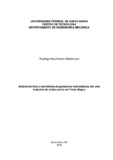| dc.contributor.advisor | Roos, Cristiano | |
| dc.creator | Martinuzzi, Rodrigo Kaufmann | |
| dc.date.accessioned | 2021-02-09T11:26:52Z | |
| dc.date.available | 2021-02-09T11:26:52Z | |
| dc.date.issued | 2018-12-19 | |
| dc.date.submitted | 2018-12-19 | |
| dc.identifier.uri | http://repositorio.ufsm.br/handle/1/20303 | |
| dc.description.abstract | The best use of photovoltaic solar energy answers the questions about planning the composition of the energy matrix in Brazil, necessary in the face of the growing demand for electric energy and the population environmental concerns. In this context, the present work aims to analyze technically and economically the installation of grid-connected photovoltaic panels in a medium-sized industry in Porto Alegre. For the development of the analysis, information and data were collected in field, which configures the applied nature of the research. Modeling and simulation were used as a research technical procedure. As a result, two photovoltaic systems were technically dimensioned, one of 23.76 kWp and another of 39.6 kWp. These two projects together with the variation of the Minimum Acceptable Rate of Return of the investor and with the system of tariff flags, configured the total of 24 scenarios modeled. Economic Engineering methods such as NPV, IRR, Simple Payback and Discounted Payback were used, as well as the LCOE levelized energy indicator, for economic viability analyzes. As the main result, the scenario with the highest economic attractiveness, corresponding to the 39.6 kWp system, obtained NPV of R$ 334,502.27, monthly IRR of 2.79%, Simple Payback of 40 months, Discounted Payback of 50 months and LCOE of 0.1374 R$/kWh. Thus, it was concluded that there is technical and economic viability of the electric power generation projects developed. This is because in 16 scenarios the IRR exceeded the MARR of the medium-sized industry used as a case in this work. | eng |
| dc.language | por | por |
| dc.publisher | Universidade Federal de Santa Maria | por |
| dc.rights | Acesso Aberto | por |
| dc.subject | Engenharia econômica | por |
| dc.subject | Sistema fotovoltaico | por |
| dc.subject | Indústria de médio porte | por |
| dc.subject | Análise de investimento | por |
| dc.subject | Economic engineering | eng |
| dc.subject | Photovoltaic system | eng |
| dc.subject | Medium-sized industry | eng |
| dc.subject | Investment analysis | eng |
| dc.title | Análise técnica e econômica de geradores fotovoltaicos em uma indústria de médio porte em Porto Alegre | por |
| dc.title.alternative | Technical and economic analysis of photovoltaic systems in a medium-sized industry in Porto Alegre | eng |
| dc.type | Trabalho de Conclusão de Curso de Graduação | por |
| dc.degree.local | Santa Maria, RS, Brasil. | por |
| dc.degree.graduation | Engenharia Mecânica | por |
| dc.description.resumo | O melhor aproveitamento da energia solar fotovoltaica responde a questões de planejamento acerca da composição da matriz energética no Brasil, necessário frente à crescente demanda de energia elétrica e as preocupações ambientais da população. Nesse contexto, o presente trabalho tem por objetivo analisar técnica e economicamente a instalação de painéis fotovoltaicos conectados à rede em uma indústria de médio porte em Porto Alegre. Para o desenvolvimento da análise, informações e dados foram coletados em campo, o que configura a natureza aplicada da pesquisa. Utilizou-se como procedimento técnico de pesquisa a modelagem e simulação. Como resultado, dois sistemas fotovoltaicos foram dimensionados tecnicamente, um de 23,76 kWp e outro de 39,6 kWp. Estes dois projetos em conjunto com a variação da Taxa Mínima de Atratividade do investidor e com o sistema de bandeiras tarifárias, configuraram o total de 24 cenários modelados. Foram utilizados métodos de Engenharia Econômica como VPL, TIR, PBS e PBD, além do indicador da energia nivelada LCOE, para as análises de viabilidade econômica. Como principal resultado, o cenário que apresenta o maior grau de atratividade econômica, correspondente ao sistema de 34,6 kWp, que obteve VPL igual à R$ 334.502,27, TIR de 2,79% ao mês, PBS de 40 meses, PBD de 50 meses e LCOE de 0,1374 R$/kWh. Assim, pôde-se concluir que há viabilidade técnica e econômica dos projetos de geração de energia elétrica desenvolvidos. Isso porque em 16 cenários a TIR superou a TMA da indústria de médio porte utilizada como caso neste trabalho. | por |
| dc.publisher.country | Brasil | por |
| dc.publisher.initials | UFSM | por |
| dc.subject.cnpq | CNPQ::ENGENHARIAS::ENGENHARIA MECANICA | por |
| dc.publisher.unidade | Centro de Tecnologia | por |


